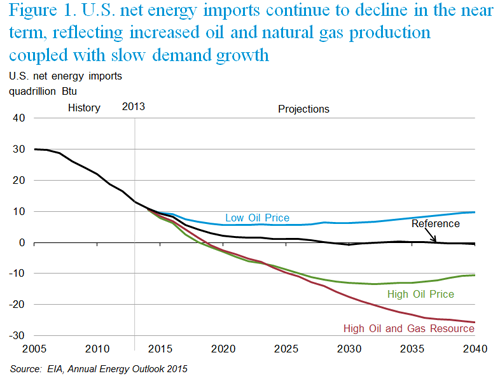Assessments released by the U.S. Energy Information Administration (EIA) and the Potential Gas Committee this month project robust growth in domestic natural gas, reinforcing prospects for continued chemical industry expansion and investment.
EIA’s Annual Energy Outlook (AEO) 2015, issued on Tuesday, projects that U.S. energy imports and exports will come into balance between 2020 and 2030 as a result of increased oil and natural gas production and slow growth in energy demand.
balance between 2020 and 2030 as a result of increased oil and natural gas production and slow growth in energy demand.
It follows the Potential Gas Committee’s biennial assessment of the nation’s natural gas resources, which reports that the U.S. has a record 2,515 trillion cubic feet (tcf) of technically recoverable natural gas as of the end of 2014. That’s the highest resource evaluation in the Committee’s 50-year history, exceeding the previous high assessment (from 2012) by 131 tcf.
U.S. chemical industry investment linked to natural gas has already reached historic levels. As of this month, 226 shale-related projects representing $138 billion are planned or underway. The new reports are terrific news for sustained supplies of natural gas and natural gas liquids (NGLs) from shale formations, which are key sources of fuel and feedstock for chemical makers in this country.
According to EIA:
Growth in production of dry natural gas and natural gas plant liquids contributes to the expansion of several manufacturing industries (such as bulk chemicals and primary metals) and the increased use of [natural gas] feedstocks in place of petroleum-based naphtha feedstocks.
Unfortunately, oil and gas production on federal lands lags far behind production on state and private lands. A new report from the Congressional Research Service finds that since fiscal year 2010, oil production on federal lands is down by 10 percent and natural gas production is down 31 percent. On non-federal lands, over the same period, oil production is up 89 percent and natural gas production is up 37 percent.
The anemic production picture on federal lands is the direct result of Administration policies such as the Bureau of Ocean Energy Management (BOEM)’s draft proposed program for oil and gas leasing for the Outer Continental Shelf. As ACC noted recently, “BOEM’s draft plan continues a clear strategy to limit oil and natural gas production on federal lands, where it has been declining for a decade. Along with restrictions for the Arctic coastal plain proposed earlier this week, current government policies are putting more resources off-limits.”
At a time when federal policies are increasing demand for energy, especially natural gas, our government should be doing everything possible to expand and diversify America’s resource base. We urge the Administration to revise its restrictive policies. Meanwhile, we look forward to development and enactment of a broad strategy to modernize America’s energy policies.
The AEO projects that combined heat and power (CHP) in the industrial sector will grow by 50% between 2013 and 2040, from 147 billion kWh to 221 billion kWh. The U.S. chemical industry is a leader in the use of CHP, also known as cogeneration, a technology that can enhance energy diversity by enabling more efficient power generation. While significantly underused today, EIA’s report may signal improvement in the coming years, which could help ease the transition in the electricity sector as many coal-fired power plants are retired.






